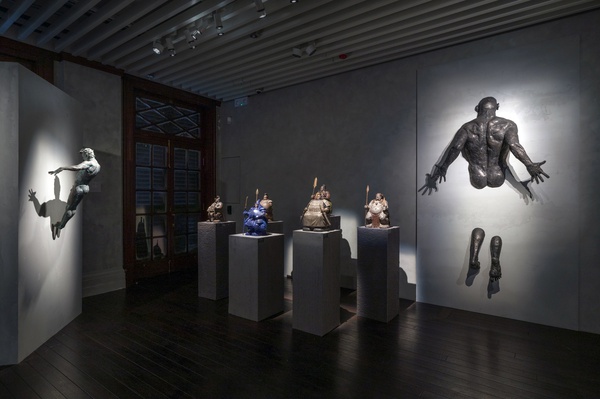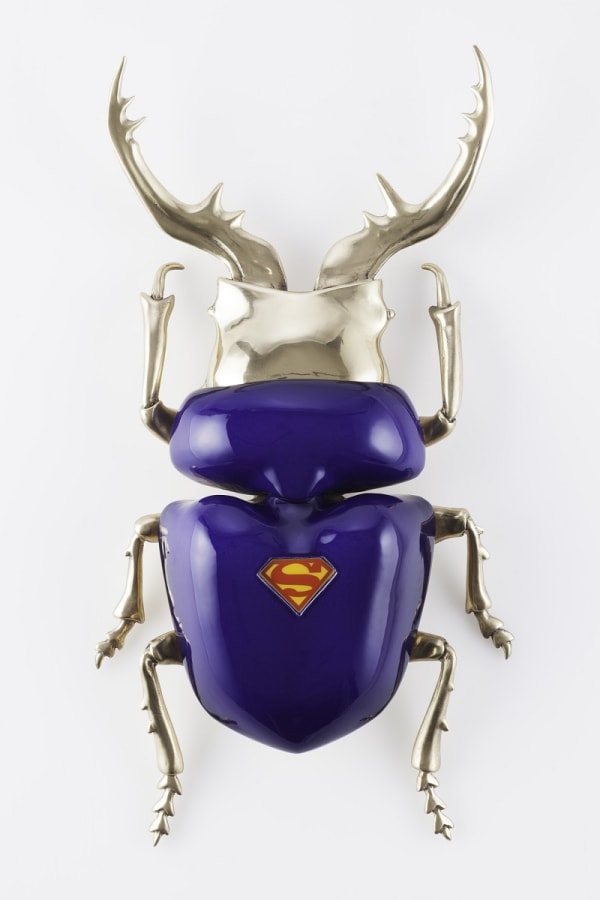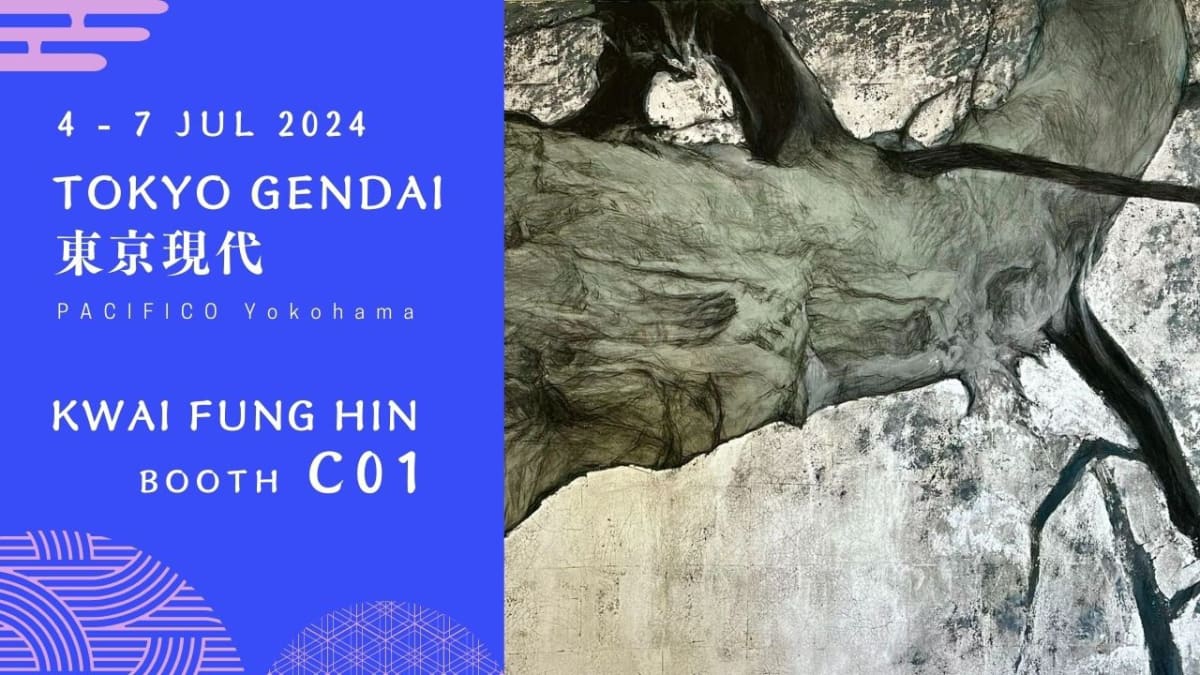Matteo Pugliese 瑪蒂奧 ‧ 培利思 b. 1969
One of the most exciting contemporary sculptors to have emerged from Europe in recent decades, Italian artist Matteo Pugliese reinvents the artistic legacy of his classical and Renaissance forefathers with fresh passion and raw imagination. Born in Milan in 1969, Pugliese showed an aptitude for drawing and sculpture from an early age, fashioning human figures from terracotta. In 1995 he graduated with a degree in modern literature from the University of Milan, with a thesis on art criticism.
Pugliese's works fall into three key series: Extra Moenia, the Guardians, and the Beetles. Pugliese is perhaps best known for his Extra Moenia ('outside the walls') classical-contemporary bronze sculptures, which showcase his ability to express the most complex physical and emotional human states through deconstructed sculptural groups. A master of the full emotional range of sculptural expression, Pugliese's Guardians series abandons classical representation entirely and explores primordial sculpture to portray protector figures and custodians of different cultures and religions. The Beetles series harks back to Pugliese's childhood in Sardinia, with miniature worlds and memories nestled within each of his creations.
-
 Il Segreto (The Secret) 《奧秘》, 2007
Il Segreto (The Secret) 《奧秘》, 2007 -
 Lungo Addio (The Long Goodbye)《後會有期》, 2008
Lungo Addio (The Long Goodbye)《後會有期》, 2008 -
 La Promessa (The Promise) 《許諾》, 2010
La Promessa (The Promise) 《許諾》, 2010 -
 Memento-a-mori 《超越生死》, 2010
Memento-a-mori 《超越生死》, 2010 -
 Anochilia Ruber Carcaris Dentata , 2011
Anochilia Ruber Carcaris Dentata , 2011 -
 Batocera Amabilis , 2011
Batocera Amabilis , 2011 -
 Cyclommatus Elveticus Ruber , 2012
Cyclommatus Elveticus Ruber , 2012 -
 Neorrinha Belligerantis , 2012
Neorrinha Belligerantis , 2012 -
 Swiss Guardian《瑞士守護者》, 2013
Swiss Guardian《瑞士守護者》, 2013 -
 Allotopus Kal-Eli , 2013
Allotopus Kal-Eli , 2013 -
 Specchio (Mirror)《鏡像》, 2013 & 2018
Specchio (Mirror)《鏡像》, 2013 & 2018 -
 Mongolian Guardian《蒙古守護者》, 2015
Mongolian Guardian《蒙古守護者》, 2015 -
 Riddle《謎題》, 2016
Riddle《謎題》, 2016 -
 Samurai Guardian VIII《日本武士守護者(八)》, 2016
Samurai Guardian VIII《日本武士守護者(八)》, 2016 -
 The Sinner《自省》, 2017
The Sinner《自省》, 2017 -
 L’abbraccio (The Embrace)《擁抱》, 2017
L’abbraccio (The Embrace)《擁抱》, 2017 -
 Chinese Guardian II 《中國守護者(二)》, 2017
Chinese Guardian II 《中國守護者(二)》, 2017 -
 La Linea (The Line)《界線》, 2017
La Linea (The Line)《界線》, 2017 -
 Balinese Guardian 《峇里守護者》, 2017
Balinese Guardian 《峇里守護者》, 2017 -
 Namibian Guardian – Himba《納米比亞守護者 - 辛巴族》, 2017
Namibian Guardian – Himba《納米比亞守護者 - 辛巴族》, 2017 -
 Celebesia Albens , 2017
Celebesia Albens , 2017 -
 Groß Zeitgeist (Great Zeitgeist) 《大時代精神)》, 2018
Groß Zeitgeist (Great Zeitgeist) 《大時代精神)》, 2018 -
 Samurai Guardian VIII 《日本武士守護者(八)》, 2018
Samurai Guardian VIII 《日本武士守護者(八)》, 2018 -
 San Sebastiano (Saint Sebastian)《聖塞巴斯蒂安》, 2018
San Sebastiano (Saint Sebastian)《聖塞巴斯蒂安》, 2018 -
 Daimon (Demon)《鬼才》, 2018
Daimon (Demon)《鬼才》, 2018 -
 Dash 《疾馳》, 2018
Dash 《疾馳》, 2018 -
 Tibetan Guardian《西藏守護者》, 2018
Tibetan Guardian《西藏守護者》, 2018 -
 Samurai Guardian XII《日本武士守護者(十二)》, 2018
Samurai Guardian XII《日本武士守護者(十二)》, 2018 -
 In your Hands, 2018-2019
In your Hands, 2018-2019 -
 Luce (Light) 《光影》, 2019
Luce (Light) 《光影》, 2019 -
 Icaro (Icarus) (伊卡洛斯), 2019
Icaro (Icarus) (伊卡洛斯), 2019 -
 Punic Guardian - Bes《迦太基守護者 -貝斯》, 2019
Punic Guardian - Bes《迦太基守護者 -貝斯》, 2019 -
 Mexican Guardian《墨西哥守護者》, 2019
Mexican Guardian《墨西哥守護者》, 2019 -
 Becoming (蛻變), 2019
Becoming (蛻變), 2019 -
 Desire《慾望》, 2019
Desire《慾望》, 2019 -
 Infinity《無限》, 2019
Infinity《無限》, 2019 -
 A Matter of Trust《交託》, 2020
A Matter of Trust《交託》, 2020 -
 Sculpture-book : The Secret《雕塑-書:奧秘》, 2021
Sculpture-book : The Secret《雕塑-書:奧秘》, 2021 -
 Sculpture-book : Enough《雕塑-書:忍無可忍》, 2021
Sculpture-book : Enough《雕塑-書:忍無可忍》, 2021 -
 Sculpture-book : GMS (Good Morning Son)《雕塑-書:早安,兒子》, 2021
Sculpture-book : GMS (Good Morning Son)《雕塑-書:早安,兒子》, 2021 -
 Sculpture-book: Specchio (Mirror)《雕塑-書:鏡像》, 2021
Sculpture-book: Specchio (Mirror)《雕塑-書:鏡像》, 2021 -
 Pachamama 1 (Mangbetu Tribe - Northern Congo)《大地之母(一)芒貝圖部落 - 剛果北部》, 2023
Pachamama 1 (Mangbetu Tribe - Northern Congo)《大地之母(一)芒貝圖部落 - 剛果北部》, 2023 -
 Pachamama 2 Xingu - Native Amazonian Tribe《大地之母(二)申谷—亞馬遜原住民部落》, 2024
Pachamama 2 Xingu - Native Amazonian Tribe《大地之母(二)申谷—亞馬遜原住民部落》, 2024 -
 Pachamama 3 Tlingit - Native Canadian《大地之母(三)特林吉特人—加拿大原住民》, 2024
Pachamama 3 Tlingit - Native Canadian《大地之母(三)特林吉特人—加拿大原住民》, 2024 -
 Pachamama 1 (Mangbetu Tribe - Northern Congo)《大地之母(一)芒貝圖部落 - 剛果北部》, 2024
Pachamama 1 (Mangbetu Tribe - Northern Congo)《大地之母(一)芒貝圖部落 - 剛果北部》, 2024
Extra Moenia
Exploring the full range of physical and emotional states through the medium of sculpture, Extra Moenia ('outside the walls') addresses dualities such as imprisonment and freedom, movement and stillness, light and shadow. This is enhanced by the stark contrast between the bare walls and the dark, intense physicality of Pugliese's enigmatic subjects, whose faces and bodies are contorted with powerful physical effort, muscles taut and veins bulging as they attempt to traverse the walls between different realms. Are they breaking free, or are they being pulled into the void?
Unafraid to portray the abject alongside the quotidian, Pugliese's deconstructed bronze figures subvert the influence of their classical Graeco-Roman cultural heritage. They share a striking visual connection with the legendary sculptural group Laocoön and His Sons, Western art's 'prototypical icon of human agony' executed in the Hellenistic Baroque style that would come to influence generations of European artists. Its sensuous aesthetic jars with the agonied contortions of its subjects, a dramatic visual dissonance that inspired Michelangelo and Raphael and sparked waves throughout art history.
Pugliese takes this a step further, with an emphasis on frank emotional realism and self-awareness that bridges languages and cultures - for example naming his works with simple verbs and nouns in English (Becoming, Rush, Dash, Boxer, Crisis), evoking controversial saints and legends in Italian (Icaro, San Sebastiano), and referencing German literature and history in others (Zeitgeist, die Mauer). Extra Moenia ultimately reflects the artist's unmistakeably contemporary convictions:
'The theme of imprisonment versus freedom is very dear to me. I have seen around me many people who live lives not theirs, people who unfortunately have never had the chance or found the strength to express themselves, people who deny or fail to nourish their true selves.'
The Guardians
Abandoning classical representation entirely, in this series Pugliese's artistic vocabulary embraces a radical stylistic change. The recurring presence of protectors throughout history, helmeted and armoured, speaks to a primordial cultural phenomenon. Pugliese's research pushed him to abandon a classical style in favour of a universal visual language inspired by cultures past and present from around the world. Squat totemic bronze, terracotta and marble Japanese samurais, European knights, Chinese warriors and African tribesmen stand to attention, their roughly-hewn faces resolute but calm. The bulbous proportions of these figures convey the majesty and mystery of prehistoric carved sculptures such as the Venus of Willendorf, the oldest representation of the human body yet to be discovered (and which is now known to have originated from Pugliese's home country of Italy). Each figure is dwarfed by their ornately detailed armour, which is ironically constructed from a mixture of nails, bolts, coins, beads, shoe strings, nails, and even electrical equipment.
Beetles
Pugliese spent his childhood years in Sardinia where he became fascinated by the island's beetles. He brought some of them home, painted them and released them back into their natural habitat. Sculpted by Pugliese from bronze and ceramic with bright and tactile finishes, each of the works from the Beetles series contains a whimsical souvenir from Pugliese's youth: thumb-sized Superman and Snoopy figurines, military miniatures, marbles, coins, even a mini Swiss army knife. Pugliese playfully names these sculptures by modifying old Latin binomial naming conventions for species, his wordplay reinventing the linguistic (as well as aesthetic) legacies of his Italian forefathers and revealing new dimensions to the tiny universe within each of his works.
-

Memento - Solo Exhibition of Matteo Pugliese
Kwai Fung Hin Art Gallery 29 Aug - 2 Nov 2024Kwai Fung Hin Art Gallery proudly presents Memento, an exhibition showcasing over 40 works by Italian sculptor Matteo Pugliese. Featuring his signature series “Extra Moenia,”...Read more -

The Cornerstone
An Exhibition Celebrating the 30th Anniversary of Kwai Fung 14 Jun - 31 Aug 2021Read more -

Seven Dimensions by Matteo Pugliese
Kwai Fung Hin Art Gallery, G/F, 20 Ice House Street, Central, Hong Kong 4 Sep - 3 Oct 2019Read more
A portrait of a studio from Matteo R Pugliese on Vimeo.















































